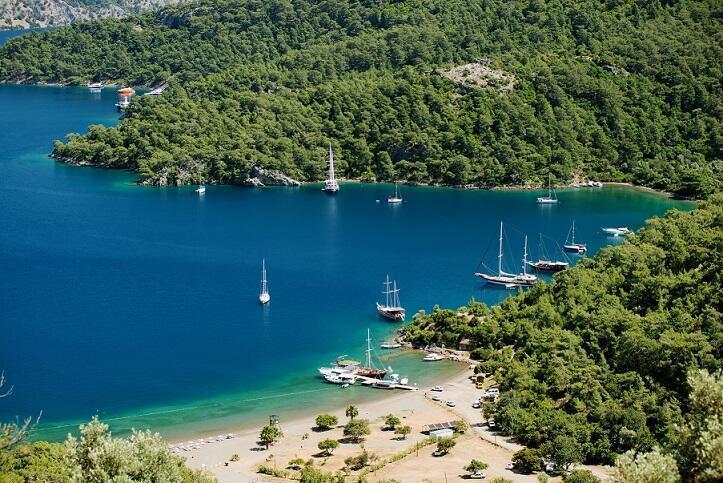Dalaman: Heart of the Aegean
Melih Uslu

Gateway to the southern Aegean, Dalyan is like the point at the end of one leg of a compass with whose other leg you can trace ever-widening circles and explore the beauties of the region. My aim is to start from Sarıgerme and branch out via Fethiye to Dalyan, Bozburun and Datça. Fifteen minutes from Dalaman Airport, Sarıgerme is ideal for water sports thanks to its sheltered bay where forest and mountains meet a shallow sea.
There are no less than exactly five diving schools in the region, a virtual underwater paradise. One of Sarıgerme’s most experienced divers, Bahadır Çevik tells us how rich the underwater caves at Aşı Cove are in terms of color and diversity of species. I stopped to pick blackberries on the Fethiye road lined with pomegranate orchards. Along this road, Göcek is a popular stop on blue cruise itineraries.
From the village of Hisarönü we continue to Karaköy, main base of the Lycian Way Ultra Marathon, running since 2010. The marathon, which covers the most exciting stretch of the 240-kilometer ancient way, is held in the last week of September (from 27 to 29).
Camping pleasure in Ekincik
After spending a night at a tent camp with my wife Filiz in Ekincik Beach (ekincikkamping.com), we have time for swimming and sun bathing. The next morning we are at Köyceğiz. Writer-journalist Çetin Altan describes the beauty of this town in Muğla province at length in his book “It’s A Good Thing There’s This Köyceğiz.”
The only Sweet Gum (aka Liquidambar) tree in the world stands here. Drifting through the sinuous canals of Dalyan, which joins Lake Köyceğiz to the Mediterranean, is like waking up from one lovely dream to another. Vibrant green slopes, the tombs of ancient kings and reeds as tall as a man glide past as the gaily painted boats move slowly through the canal. And the blue crab feast offered on board is just the icing on the cake. One of the loveliest open-air markets in the Dalaman area is set up Mondays at Köyceğiz.
Fresh fruits and vegetables, medicinal herbs, butter, country cheeses and homemade ice cream are just a few of the things you can find here. The turnoff for Bozburun is 21 kilometers along the Marmaris - Datça road. Hisarönü at the entrance to the peninsula is known for its horse farms and beautiful beach. Further along the road, Orhaniye Cove greets us with its marina and island dotted with ancient ruins. Here, too, is the spit of reddish sand known as Maiden Beach, where you will feel as if you are walking on water.
The village of Turgut three kilometers ahead is famous for its hand-woven carpets. And the Anatolian pyramid on the road to the waterfall is without a counterpart in the world. Rising atop a rocky slope that overlooks the valley, this pyramid is actually a burial chamber built by Egyptian warriors who came to the region between the 4th and 2nd centuries B.C.
Impressive panorama
After Selimiye we are on a road of stunningly beautiful views. Bozburun Harbor is like a giant pool. Musician Bülent Ortaçgil, a well-known personality in the area, expresses his feelings in his song, Bozburun: “It starts in the deserted coves… the song of the scents. We sent the sun to all the colors; neither child’s voice nor city hum, our only friend now is the phosphorescence on the water.” A small quay lined with fish restaurants catches our eye on Bozburun Cove, chock full of yachts. Earning a livelihood from fishing and sponge-fishing up to the 1970’s, Bozburun today is the region’s biggest center for yacht building. According to Cumalı Akdemir, owner of a popular local restaurant, the world’s biggest blue cruise gulet at 54 meters in length is currently being built here. Every curve along the 8-kilometer road from Bozburun to Taşlıca affords a new view.
The village of Cumhuriyet (formerly Saranda) boasts an impressive panorama that includes the island of Simi (Symi). There are many islands just half an hour away by boat on the open sea, almost none of them inhabited. Taşlıca at the tip of the peninsula is also well worth seeing. Water is still drawn from ancient wells in this village famous for its free-roaming horses. Meanwhile, Serçe (Sparrow) Harbor on the gravel road out of the village is the nearest spot on land to get to Loryma Castle. Finally we’re on our way to Datça.
A turnoff to the right three kilometers before the town center points to Old Datça, where the historic windmills are the last surprise before New Datça. The road from Datça to Knidos boasts landscapes reminiscent of a deserted island. The peninsula’s most beautiful coves, Hayıtbükü and Palamutbükü, come after the turnoff for Mesudiye.
And at Knidos on the road from Yazıköy we fall plumb into the heart of nature and history. Shops selling the famous Datça threesome, fish, honey and almonds, are rife here. To hear the experienced merchants tell it, the finest quality almonds are the “nurlu.” The fish too are fatter and more flavorful in winter. And the area’s intensely aromatic pine honey is widely available. It’s a good thing we came here!
*Melih Uslu is the author of the book “See and Live the Aegean” (Ege’yi Gör ve Yaşa, Mona Books, July 2019)
















